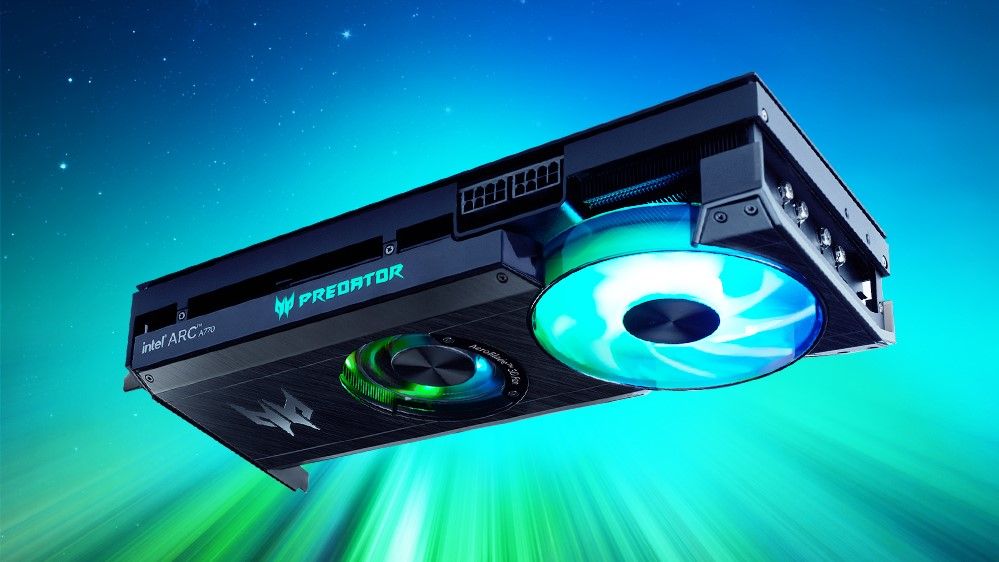
Graphics card overclocking is generally reserved for the very top-end GPUs – those that can break world records in this benchmark or that when juiced up – but an expert overclocker out there decided to push Intel’s A770 to its limit, even though it can’t hold a ray-traced candle to Nvidia or AMD’s best graphics cards.
SkatterBencher managed to crank up an Acer Predator BiFrost A770 to 3.59GHz (at 1.305V) – 50% faster than the 2.4GHz boost speed of the GPU out of the box – in an effort to see what Intel’s best can do, as Tom’s Hardware reports.
As ever with extreme overclocking, exotic cooling was employed to get the A770 running so fast – liquid nitrogen in this case.
SkatterBencher explains that their goal was to grab the title of the world’s fastest Intel Alchemist GPU, and that would require both getting the highest clock speed ever seen on Arc, and achieving a record benchmark (among Arc owners) to boot.
Certainly almost touching 3.6GHz qualifies as the highest ever seen. (The one previous attempt at ramping up Alchemist with liquid nitrogen happened a few months back, but wasn’t nearly as successful, coming across an apparent ‘temperature bug’ as detailed in this Reddit post).
As for setting a new benchmark record, SkatterBencher turned to 3DMark. The A770 wasn’t able to be used at 3.6GHz, of course, as the GPU was highly unstable at this speed, and only allowed for idling for a couple of seconds before the system would lock up. Ouch.
The best SkatterBencher could do with a light workload running was 3.4GHz. To run a 3DMark benchmark, a pretty demanding task (relatively speaking), the overclocker managed to hit 3.1GHz at best, or 3GHz to actually complete the benchmark run.
The results were new records for an Intel Alchemist GPU in every 3DMark test except for one (Fire Strike), with, for example, Time Spy witnessing a score of 16,711. That blew away the old record of 13,259 for an Intel graphics card (which was achieved at 2.8GHz).
Analysis: An impressive first crack – so, what about Battlemage?
Considering that previous attempts at overclocking Intel’s Alchemist GPUs have come unstuck due to various issues, it’s good to see a major overclock achieved with liquid nitrogen.
Indeed, SkatterBencher reckons that given the fact that Alchemist is Intel’s first crack at a modern GPU, achieving a “maximum frequency of over 3.5GHz is impressive.” After all, this isn’t that far behind Nvidia in terms of pure clock speeds, given that the RTX 4090 for example didn’t get a whole lot faster than this (3.8GHz). And the A770’s boost speed here is practically up with the RTX 4080 (3.615GHz).
Can we expect more with Battlemage in 2024? Probably, as the next-gen of Intel’s GPUs should be taking strides forward on all fronts. The catch might be – if the most recent buzz from the rumor mill is right – that there won’t be any higher-end (B700 series) Battlemage GPUs to overclock (which were previously rumored). And, perhaps, there might only be B300 models, with no B500 offerings either – and Intel just going for the budget end of the graphics card market.
It’s too early to make that call, of course, but we hope the theories that Intel is seriously narrowing its Battlemage ambitions in terms of the scope of the range prove to be incorrect. Even if this pans out to be true, it has to be said that good value proposition budget GPUs remain the most important piece of the puzzle Intel could provide – as it’s where Nvidia in particular is often coming up short.
Services Marketplace – Listings, Bookings & Reviews
